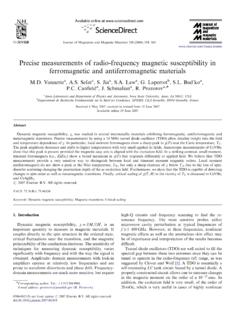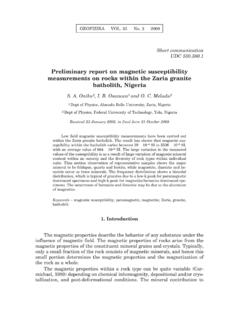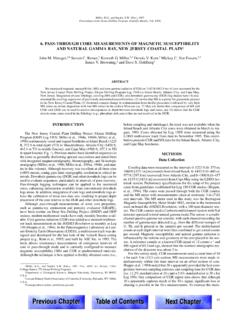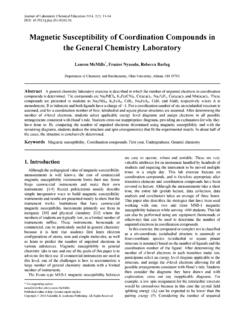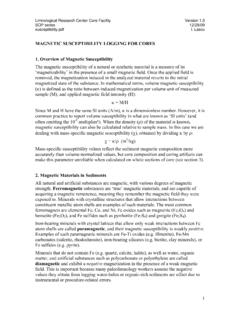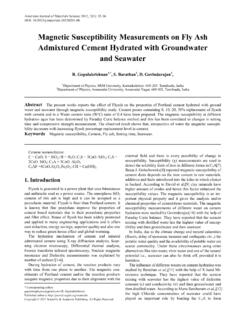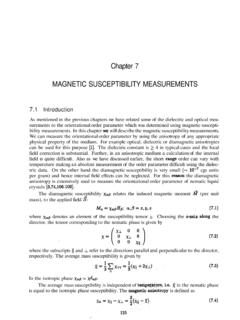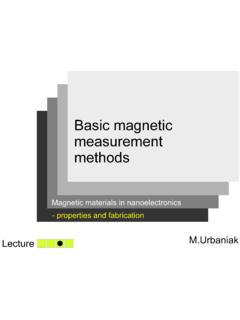Transcription of Implications of Soil Magnetic Susceptibility …
1 International Journal of Scientific and Research Publications, Volume 4, Issue 5, May 2014 1 ISSN 2250-3153 Implications of soil Magnetic Susceptibility Measurements from the Waste Site Deposit of Independence Hall, Kwame Nkrumah University of Science and Technology (K. N. U. S. T), Kumasi. B. Boadi, K. Preko, L. K. Amekudzi Department of Physics, Kwame Nkrumah University of Science and Technology, Kumasi, Ghana. Abstract- The applicability of Magnetic Susceptibility measurements was tested to detect soil contamination from a waste site deposit in the topsoil in the vicinity of the Independence Hall, Kwame Nkrumah University of Science and Technology (KNUST), Kumasi.
2 Magnetic Susceptibility (volume specific) measurements of the near surface topsoil (~ 15 cm top layer) were taken along four radial profiles from the centre of the 100 m2 deposit at 1 m intervals using the Bartington MS2 (MS2D Field Loop Sensor) Magnetic Susceptibility system. The results of the measurements showed that the near surface soil around the waste site deposit lies in the region of paramagnetic and (canted) anti- ferromagnetic materials. The average Magnetic Susceptibility values recorded along profiles taken in the direction of run-off was 350 10-5 SI, and this was about 7 times higher than that observed along the other profiles.
3 Atmospheric particulates from vehicular emissions and other contaminants from the waste site infiltrate the soil through the agency of rainfall. This result will be useful for understanding the extent of pollution from waste deposition sites. The continuing use of the area as a waste site deposit should be discouraged since it poses a high pollution threat. Index Terms- Magnetic Susceptibility , antiferromagnetic, contaminant, waste deposit I. INTRODUCTION he Magnetic properties of soils are largely due to the presence of ironic compounds, in particular, oxides and sulfides of iron.
4 The level of concentration of iron oxides in the soil depends on the age and nature of the soil , pedogenic and biological activities, and soil temperature. The distribution of pollution in soil depends on many factors, of which distance from the source, landscape morphology, vegetation and dominant wind direction are the most influential (Klu iarov et al., 2007). Iron originates from the primary minerals contained in the parent materials, thus, it becomes concentrated in the weathered material because of its low solubility under oxidizing conditions at the natural pH.
5 Iron is less easily integrated than aluminum within the clayey secondary phylosilicates and, therefore, iron is generally in the form of iron oxides and hydroxides, such as hematite, limonite, goethite, lepidocrite, magnetite, and maghemite (Stacey and Banerjee, 1974). soil particles differ in their degree of magnetism because of differences in their iron components, which control the Magnetic order within the soil (Parker, 1983). In stable soils, Magnetic Susceptibility gradually increases from the deep soil layers to the surface, but in degraded soils, this pattern is absent and Magnetic Susceptibility is lower.
6 Investigations into topsoil magnetism lead to useful applications in the fields of archaeology, hydrology and sedimentology, landslide characterization and environmental pollution (Dearing, 1999). Since the 1970s, Magnetic Susceptibility has been used in environmental studies (Thompson et al., 1980; Oldfield, 1977, Thompson and Oldfield, 1986), many of which mainly focused on identification of the sources of sediments. In most cases, the Bartington Susceptibility meter for field measurements has been used though no standard procedure is known to carry out such investigations (Strzyszcz, 1999).
7 The compatibility of different set-ups of instruments used for Magnetic Susceptibility measurements has been shown in Schibler et al.,(2002) to be very consistent both for low and high values. Magnetic Susceptibility measurements on top soils have often been used during the last few years to detect anthropogenic pollution (especially from heavy metals) on soil and sediment samples (Schmidt et al., 2005). The use of soil Magnetic signatures to assess soil degradation is based on differences in the specific behaviour of iron components, which have near full control over the Magnetic order in the soil (Strzyszcz et al.)
8 , 1996). Magnetic Susceptibility measurements find useful applications in Magnetic and magneto-mineralogical studies of forest soils (Kapicka et al., 1999), soil contamination studies (Strzyszcz et al., 1996, Canbay, 2009) among others. This paper discusses the Implications of near surface (~ 15 cm top layer) Magnetic Susceptibility measurements from the region surrounding the waste site deposit at the Independence Hall, K. N. U. S. T, Kumasi. This deposit is one of the many waste site deposits found on the campus of K.
9 N. U. S. T. The results from these measurements would help educate the public on the impact of such waste sites on the environment. Background of Magnetic Susceptibility , Xm From the atomic point of view a material may have a net Magnetic moment resulting from the rotation of its electrons in the various shells around the nucleus or the electron spin about their axes. The Magnetic behaviour of a material is as a result of Magnetic moments produced from these effects. Magnetic Susceptibility Xm, (Dearing, 1999) is the ratio of magnetization T International Journal of Scientific and Research Publications, Volume 4, Issue 5, May 2014 2 ISSN 2250-3153 M [Am-1] to the Magnetic field strength H [Am-1].
10 Positive values of Xm imply that the induced Magnetic field is in the same direction as H. The direction of the induced field is opposite to H when Xm is negative. In Magnetic prospecting Xm is the fundamental property whose spatial distribution is determined. Based on the material Magnetic Susceptibility , materials are classified as paramagnetic (with unpaired electrons in incomplete electron shells slightly positive Xm), diamagnetic (where all electron shells are filled with no net Magnetic moment, slightly negative Xm, common to all material), ferromagnetic (containing unpaired electrons in incomplete electron shells, Magnetic moment of each atom is coupled in parallel arrangement with surrounding domain, electron orbits overlap, strongly positive Xm)










